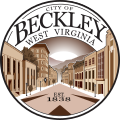Beckley, West Virginia | |
|---|---|
 Main Street in downtown Beckley in 2023 | |
| Nickname: Smokeless Coal Capital [1] | |
| Motto: "The Gateway to Southern West Virginia" | |
 Location of Beckley in Raleigh County, West Virginia | |
| Coordinates: 37°46′27″N81°10′52″W / 37.77417°N 81.18111°W [2] | |
| Country | United States |
| State | West Virginia |
| County | Raleigh |
| Government | |
| • Mayor | Ryan Neal [3] [4] |
| Area | |
| 9.51 sq mi (24.63 km2) | |
| • Land | 9.50 sq mi (24.60 km2) |
| • Water | 0.012 sq mi (0.03 km2) |
| Elevation | 2,405 ft (733 m) |
| Population | |
| 17,286 | |
| • Density | 1,821.5/sq mi (703.28/km2) |
| • Metro | 123,373 (US: 317th) |
| Time zone | UTC−5 (Eastern (EST)) |
| • Summer (DST) | UTC−4 (EDT) |
| ZIP codes | 25801, 25802, 25926 |
| Area codes | 304 and 681 |
| FIPS code | 54-05332 |
| GNIS feature ID | 2390563 [2] |
| Website | http://www.beckley.org/ |
Beckley is a city in Raleigh County, West Virginia, United States, and its county seat. The population was 17,286 at the 2020 census, making it the ninth-most populous city in the state. It is the principal city of the Beckley metropolitan area of Southern West Virginia, home to 115,079 residents in 2020. Beckley was founded on April 4, 1838, and was long known for its ties to the coal mining industry. It is the home of the West Virginia University Institute of Technology, as well as an annex of Concord University and the University of Charleston. [7]
Contents
- History
- Geography
- Geology and topography
- Water
- Climate
- Demographics
- 2010 census
- 2000 census
- Arts and culture
- Education
- Media
- Newspaper
- Radio
- Television
- Transportation
- Highways
- Rail
- Air
- Notable people
- In popular culture
- See also
- References
- External links
Beckley hosts the Beckley VA Medical Center (VAMC) [8] offering comprehensive medical services to veterans. Additionally, the city is home to Raleigh General Hospital and Beckley Appalachian Regional Hospital (BARH), [9] both of which provide a wide range of healthcare services to the local and surrounding communities.
Apart from its significance in healthcare, Beckley is renowned for the Tamarack Marketplace. Situated off Interstate 64, Tamarack stands as a cultural cornerstone, showcasing the artistic heritage and craftsmanship of West Virginia. The venue features work from state artisans, offering visitors a glimpse into the region's culture and traditions. [10] [ better source needed ]







